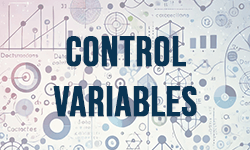
Control variables play a pivotal role in scientific methodology, ensuring the integrity of research outcomes. These are specific types of variables that researchers keep constant throughout an experiment to minimize external influence and ensure that the results accurately reflect the relationship between independent vs. dependent variables. The following article will explain everything you need to know about control variables and how they can help to avoid research bias.
Definition: Control variables
Control variables are factors in a study that are kept steady to avoid them influencing the dependent variable. This way, they limit the impact of possible extraneous variables and confounding variables, which increases internal validity. They help to create replicable, verifiable data (i.e. in statistics) from direct experimentation, observation, and sampling by setting hard limits. They also allow us to bypass ‘false’ causatives in observational studies. As a single study may use many different types, they can be categorical variables as well as quantitative variables.
Types of control variables
There are two types of control variables, experimental and non-experimental ones.
Experimental
Experimental control values let us isolate the dependent and independent variables in closed experimental conditions. They are called the ‘lab’ variety.
Non-experimental
Control variables in non-experimental research are similar. However, they’re tailored much more towards validating observations of environmental conditions, natural phenomena, particularly human behaviour.
Non-experimental variables are helpful when potential confounding causative factors (i.e. income, age, gender) may not be removed entirely from samples for ethical, legal, or practical reasons. Instead, they monitor or neutralize data on known causatives.
How to control variables
Three advanced techniques that use control variables help remove bias from sample sets – if applied correctly. Here is how they work.
Random assignment
It is simply impossible to consider and even find all possible confounding variables and other uncontrolled variables in an experiment. This is why researchers often assign subjects to their groups randomly, spreading the possible factors equally.
Modern statistical studies may use a digital database to calculate random samples rather than a simple glass jar. Demographic weighting (i.e. stratification) might also be applied to better model divided random populations.
Standardized procedures
Experiments always have a standardized procedure to follow, so not even time can impact the results. A steady sequence of tasks also ensures that other chores of the experiment are also always conducted in the same way.
Statistical controls
Sometimes, removing all traces of extraneous influence is impossible. By applying modelling , weighting, and averaging based on what’s known about the factors you’re trying to account for, a more realistic statistical picture may emerge. This means, that the predictor variable, also called an independent variable, is complemented by the control variables. Suitable statistical techniques are a simple linear regression analysis and ANOVA.
Control variables vs. Control groups
Control variables shouldn’t be confused with control groups! Control groups are governed by control variables, allowing the creation of a ‘neutral’ subsample.
| Control Variables: | Control Groups: |
| Set a distinct rule or base value for a variable causative factor. | Are single-study groups that create a frame of reference for other samples. |
| Remain completely consistent across time. | Are controlled by variables. |
| Can affect sets or a singular value. | Do not directly affect statistical results. |
| Are not created from a sampled population. | Are always created from a population of samples. |
| May change over time. |
Other types of variables
- independent variables
- dependent variables
- independent vs. dependent variables
- explanatory vs. response variables
- control variables
- mediator variables
- moderator variables
- mediator vs. moderator
- confounding variables
- extraneous variables
- categorical variables and qualitative variables
- quantitative variables and numerical variables
- nominal variables
- ordinal variables
- discrete variables
- continuous variables
- interval variables and ratio variables
- random variables
- latent variables
- composite variables
- binary variables
FAQs
A control variable is a scientific safeguard that details a factor in a study that should (ideally) be kept the same. It can also set out what factors should be accounted for and excluded from causative arguments.
Control variables add immense statistical power and validity. They are an easy-to-use, effective way to guard against confounding factors that might warp our understanding of a complex topic.
Variables can be controlled through randomized assignment of research subjects into the test group, spreading possible influences evenly. Another method can be standardized procedures, ensuring the continuity of the impact. And if these are not enough, statistical methods such as regression analysis and ANOVA can be helpful.
